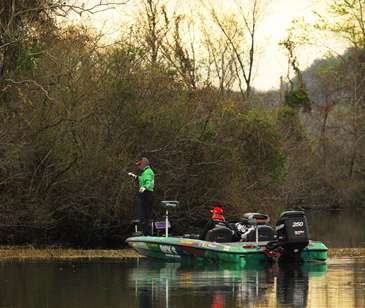
Welcome to the Lowrance Forecast, where I give you my take on how weather and other conditions are likely to influence your fishing trips. Rather than focus on a specific region or type of water in this second installment, I want to tell you all about a phenomenon that occurs when the water gets so hot it trips over itself. It's called the turnover, and it occurs when a thermocline divides layers of water in a lake or reservoir.
Season: Dog days of summer
Water temperature: 90-plus degrees
Body of water: It depends; some reservoirs with current experience a thermocline to a lesser degree than lakes and reservoirs without any water flow
When you think of summer patterns, you probably think of deep cranking, football jigs and Carolina rigs. You may also think of tough fishing. If these things describe your summertime fishing, there's a chance you're not taking into account a very important factor in summer fishing — the thermocline.
A thermocline develops on a lake (I say lake because they're most often found on slow or stagnant bodies of water) when the cooler, top layer of water sinks below the warmer, lower layer. The top layer didn't used to have enough oxygen to support fish, so the bass were pushed deep. However, now that the bottom layer has become the top layer, the fish can move back up with the oxygenated layer. On a lake with a strong current, this is much less pronounced; the current continually mixes the water.
In between the top layer (very warm and pretty well oxygenated) and the bottom layer (cool or cold with little oxygen) is the thermocline, and that's where the bulk of the aquatic life can be found in the summer. On some lakes you'll find the thermocline in just 8 or 10 feet of water, while on others (usually deeper lakes), it'll be found between 15 and 30 feet deep.
The thermocline is usually just a few feet wide and represents the last band of water with both good oxygen content and mild temperatures. That's why it's so popular.
On lakes where a thermocline is defined, traditional summer patterns may not be as effective as other techniques. You can catch 'em deep cranking (even if your lure is diving below the thermocline); I've done it. But what I've found is that the fish I caught were following the bait down below the thermocline before grabbing it.
When the thermocline is deeper, like it will be on most of the water bodies across the country, it's best to hit the ledges, brushpiles, rockpiles and other good stuff they like to hold on. These are especially good if they're on or next to a point. My Lowrance HDS unit picks these up with the Down Imaging and Structure Scan and makes it look like you're watching TV. On these kinds of cover you want to fish a football jig, Carolina rig or a big worm. However, when fishing a natural lake or pond, you want to look for something else on your electronics, a broken-up line that is a different color than the rest of the water — that horizontal band is the thermocline.
You can see the thermocline on your graph, and the fish will be in or above it. You may see a good looking creek channel beneath it, but there won't be any fish on it even though the water temperature may be 90 degrees or more. Rather than forcing fish to follow a deep diver like a Strike King 6XD into the oxygen-depleted area below the thermocline, throw shallow running crankbaits, like a Strike King Series 2, flip a tube or even use topwater baits.
Think of when Denny Brauer won the 1998 Classic in August at High Rock Lake in the heat of the summer. He won it in inches of water when a lot of guys were fishing deep. Why? Because that super-shallow water had the most oxygen in it. Granted it was hotter, but it was easier for the fish to live there.
While going against the grain and fishing shallow in the summer may not win you $150,000 like it did for Denny, it can make your days on the water this summer more pleasant.




